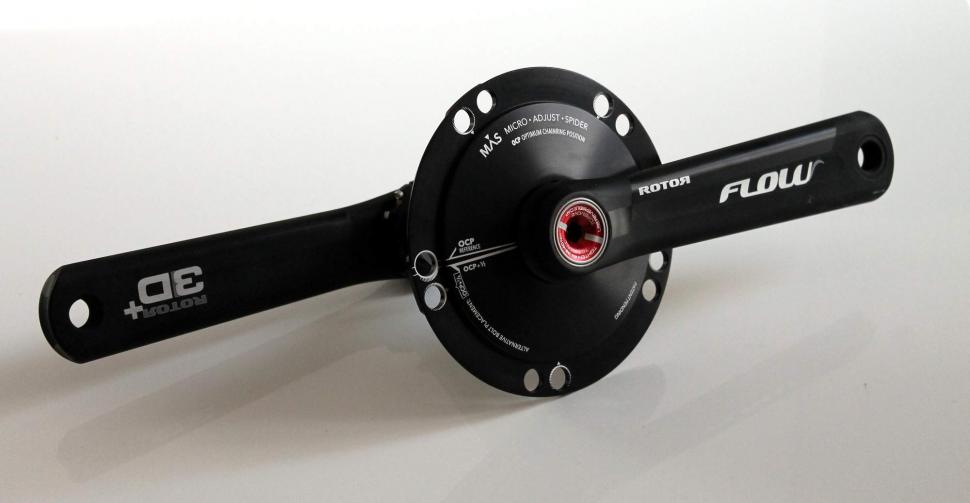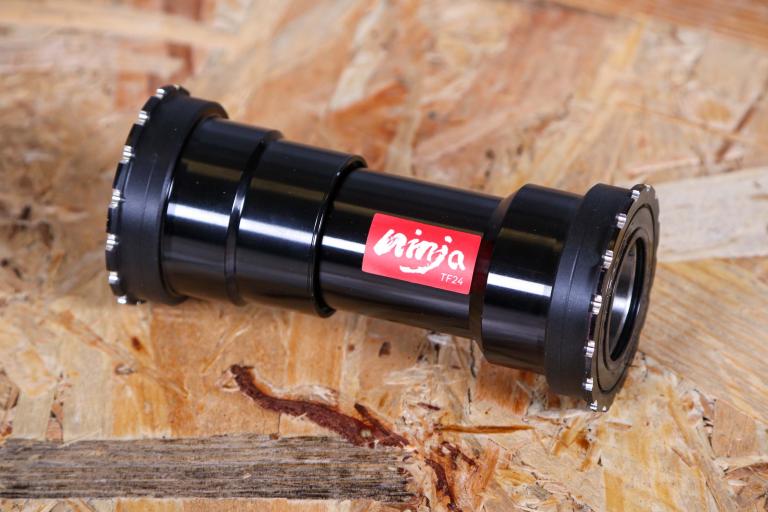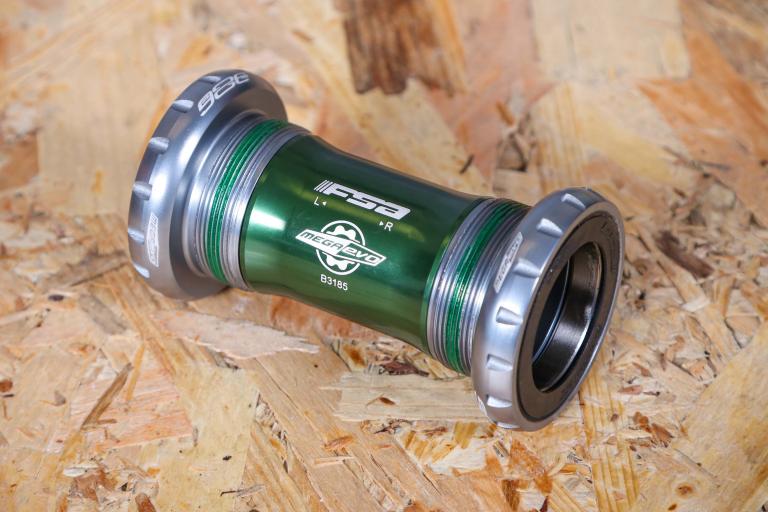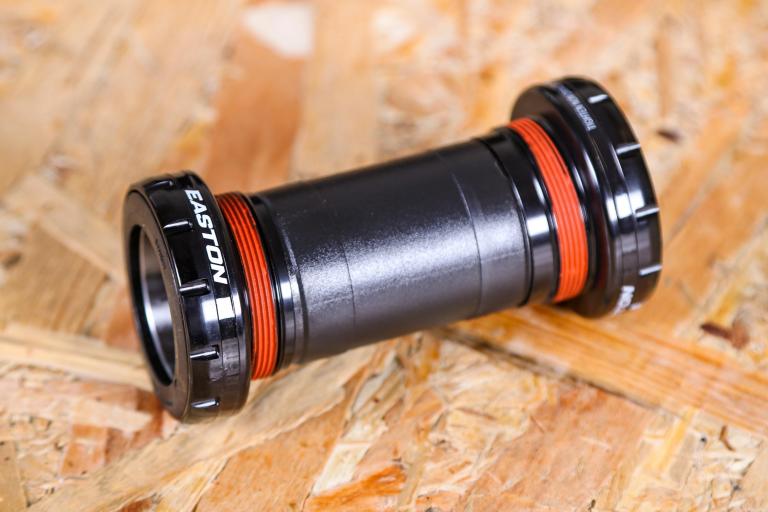- News
- Reviews
- Bikes
- Components
- Bar tape & grips
- Bottom brackets
- Brake & gear cables
- Brake & STI levers
- Brake pads & spares
- Brakes
- Cassettes & freewheels
- Chains
- Chainsets & chainrings
- Derailleurs - front
- Derailleurs - rear
- Forks
- Gear levers & shifters
- Groupsets
- Handlebars & extensions
- Headsets
- Hubs
- Inner tubes
- Pedals
- Quick releases & skewers
- Saddles
- Seatposts
- Stems
- Wheels
- Tyres
- Tubeless valves
- Accessories
- Accessories - misc
- Computer mounts
- Bags
- Bar ends
- Bike bags & cases
- Bottle cages
- Bottles
- Cameras
- Car racks
- Child seats
- Computers
- Glasses
- GPS units
- Helmets
- Lights - front
- Lights - rear
- Lights - sets
- Locks
- Mirrors
- Mudguards
- Racks
- Pumps & CO2 inflators
- Puncture kits
- Reflectives
- Smart watches
- Stands and racks
- Trailers
- Clothing
- Health, fitness and nutrition
- Tools and workshop
- Miscellaneous
- Buyers Guides
- Features
- Forum
- Recommends
- Podcast
review
 Rotor Flow cranks
Rotor Flow cranks£399.00
VERDICT:
Stiff cranks offering marginal aero advantage but at a price
Weight:
558g
Contact:
www.rotoruk.co.uk
At road.cc every product is thoroughly tested for as long as it takes to get a proper insight into how well it works. Our reviewers are experienced cyclists that we trust to be objective. While we strive to ensure that opinions expressed are backed up by facts, reviews are by their nature an informed opinion, not a definitive verdict. We don't intentionally try to break anything (except locks) but we do try to look for weak points in any design. The overall score is not just an average of the other scores: it reflects both a product's function and value – with value determined by how a product compares with items of similar spec, quality, and price.
What the road.cc scores meanGood scores are more common than bad, because fortunately good products are more common than bad.
- Exceptional
- Excellent
- Very Good
- Good
- Quite good
- Average
- Not so good
- Poor
- Bad
- Appalling
We first saw Spanish outfit Rotor's brand new Flow cranks at Eurobike last year, and worked hard at getting a pair in for test as soon as possible. So for the last couple of months I've been riding the new aero crankset, a niche market in itself, and have been impressed with their stiffness. And their aero properties? Well that's a little harder to quantify.
The Flow cranks were the result of a collaboration between Robby Ketchell, the Director of Sport Science at the Garmin-Sharp pro cycling team, and the Spanish company that only makes cranks and chainrings (of the non-round variety). They designed the arms of the cranks using Computer Fluid Dynamics (CFD) software, which allows them to mimic wind-tunnel testing without the prohibitive costs of hiring such a facility.
The shape of the arms is claimed to be more aerodynamic than a regularly shaped crank arm (usually that of a sharp sided rectangle) throughout the full 360 degree rotation. Their findings give them the confidence to claim a saving of 6 seconds on a 40km time trial, if averaging 200 watts. Now, as with most claims that come with the latest aero products, the benefits are marginal at best. But a performance increase is still an increase, no matter how small. And as well all know, the Tour de France can come down to mere seconds even after three weeks of racing. The deciding factor is how much you think a small gain is worth. Pros obviously will want it, but what's not to say that we all can't enjoy the benefits?
Unfortunately the roadcc budget doesn't extend to hiring a wind-tunnel to come to an objective answer about how much advantage we can wring out of them. I did however try some basic road testing, using a Powertap and testing on the same stretch of road before and after fitting these cranks. However, there were so many variables and finding two days with identical wind conditions, temperature and other factors identical enough to be able to rule them out, just wasn't happening, so sadly I abandoned any hope of a scientific test. I'll have to take Rotor's claims that they're faster.
Of qualities I can comfortably comment on, they're as stiff, if not fractionally stiffer, than the Force cranks they replaced. At 558g for the cranks on my scales they're not the lightest from the Rotor catalogue, but there's at least no significant weight penalty in fitting these.
They're made from aluminium using the company's unique drilling process. They drill three full-length holes into the crank arms, right from the axle to the pedal, eliminating as much material as possible. This also contributes to the stiffness as well. The cranks are compatible with most bottom bracket standards, from 24 to 30mm axles, with Rotor's UBB (Universal Bottom Brackets) system.
The spider features Rotor's unique Micro Adjust Spider (MAS) that makes for easy and perfect setup with their chainrings, because there's more available positions. However, I wanted to asses the cranks on their own merits so I fitted them with a pair of SRAM 53/39 chainrings, identical to those on the previous cranks, so I could isolate my testing to just the cranks. I also wanted to see if the cranks are a suitable aftermarket upgrade for racers and time trialists who may be interested in the aero benefits, but perhaps are willing to leap into the world of non-round chainrings.
Installation was very straightforward, after some head scratching at the inadequate instructions. While the exploded diagrams are helpful, the lack of written instruction is less so. A little more detail in explaining the proces wouldn't go amiss.
To install into a PressFit 30 bottom bracket, as I did, is as simple as lining the necessary spacers up, sliding the axle attached to the non-driveside crank arm, lining up the driveside crank, and tightening up the red axle bolt with a 8mm hex tool. Flip the bike around and the threaded collar now sitting between the frame and the crank arm can be used to remove any play in the bearings, and secured in place once you're satisfied with a small 2mm bolt.
Removal is a little more tricky, but fairly easy. First of all you need a Shimano cassette removal tool (TL-LR15). First unscrew the red crank bolt, then with the cassette tool unthread the slim metal collar that sits flush inside the crank arm. Reinsert the red bolt then, flipping the collar, you screw it in place over the crank arm bolt. Then you simply unscrew the red bolt and that pulls the driveside crank off the axle. Easy. Once you know how.
I've enjoyed riding the Flows, and my only gripe is the matte black alloy finish tends to scuff and mark quite easily. It's an understated looking finish and less polished than the crank it replaced, and it probably won't suit all bikes. It functions excellently, is stiff and reasonably light and, if the aero claims are to be believed, will make you faster, though it's hard to back up these claims in real world riding. Without rings they're SRAM RED money so right at the top-end of the slider.
Verdict
Stiff cranks offering marginal aero advantage but at a price.
road.cc test report
Make and model: Rotor Flow
Size tested: 172.5mm
Tell us what the product is for, and who it's aimed at. What do the manufacturers say about it? How does that compare to your own feelings about it?
The aero shape of the crank arms is specifically designed from a purely functional perspective in performance and not just aesthetics using the Computer Fluid Dynamics (CFD) design. The CFD is a software program that can simulate an actual wind tunnel test at the same time enabling us to isolate a specific part of the bicycle in motion. The rigidity is not compromised, as it is 10% stiffer and lighter (563 g w/o chainrings – 175 mm) than most aero cranks on the market.
Tell us some more about the technical aspects of the product?
The aero profile of the crank arm has been optimized according to the varying airflow the crank encounters from the axle to the pedals, throughout the 360° pedal stroke. The crank arms and the spider are designed separately in order to acquire a maximum advantage of the crank's aero profile.
Time Savings: An athlete is 26.4 seconds faster when averaging 200 watts over a 180 km distance.
The Micro Adjust Spider (MAS) ensures perfect Q-Ring setup, offering adjustment increment gaps half that of classic spiders.
Rate the product for quality of construction:
7/10
The unique drilling of the arms makes them pretty light and they're right up with in the stiffness dept.
Rate the product for performance:
7/10
Really hard to assess the aero claims that come with these (or most aero products) so it's really a case of taking their word for it. They've certainly not felt faster in testing.
Rate the product for durability:
7/10
Rate the product for weight, if applicable:
7/10
They're not as light as Rotor's lightest offerings, but they're still a competitive weight.
Rate the product for value:
6/10
They're expensive because the £399 doesn't include any chainrings, you have to buy them separately or provide your own. That makes them a very expensive upgrade for what might only be a smidgen of an aerodyanmic improvement over regular cranks. If you're racing against the clock however, they could be the difference between getting a new PB and not.
Tell us how the product performed overall when used for its designed purpose
They performed very well, and have not given any trouble during the test period. Their stiffness is appreciated for general riding, racing and climbing, even if their aero benefits are harder to identify.
Tell us what you particularly liked about the product
They look really good.
Tell us what you particularly disliked about the product
The crank arms scuff and mark quite easily.
Did you enjoy using the product? Yes..
Would you consider buying the product? I'm not sure.
Would you recommend the product to a friend? To my TT friends, yes.
About the tester
Age: 31 Height: 180 Weight: 67
I usually ride: My best bike is:
I've been riding for: 10-20 years I ride: Every day I would class myself as: Expert
I regularly do the following types of riding: road racing, time trialling, cyclo cross, commuting, touring, mtb,
David worked on the road.cc tech team from 2012-2020. Previously he was editor of Bikemagic.com and before that staff writer at RCUK. He's a seasoned cyclist of all disciplines, from road to mountain biking, touring to cyclo-cross, he only wishes he had time to ride them all. He's mildly competitive, though he'll never admit it, and is a frequent road racer but is too lazy to do really well. He currently resides in the Cotswolds, and you can now find him over on his own YouTube channel David Arthur - Just Ride Bikes.




No. New world economics notwithstanding, prices of tech stuff have mostly come down a lot over the decades, sometimes in actual numbers of £s and ...
Sign it better!...
+1 for the physio. I'd knee problems a few years back - except the problem wasn't really my knees, it was muscles above and below. I doubt I'd have...
It's still 'better' than the 6 points and small fine the guy that broke my back [and ulna, and knee, and 11 ribs] got.
If a redtop newspaper hasn't headlined this incident FIRKIN HELL!! by now, I'm going to be questioning my whole Britishness....
Have a look here - https://road.cc/content/forum/bike-respray-312357
In what way does he do that? I am sure you won't mind providing information to support your comment. Thanks.
Just another SUV driver in the Bible there. His conveyance was like a whale - but an earlier traveller had something as roomy as an ark!...
Kendo (Japanese: 剣道, Hepburn: Kendō, lit. 'sword way' or 'sword path' or 'way of the sword') is a modern Japanese martial art, descended from...
So the same cop has given very different reasons for NFA to the rider and to his MP....